
Conducting a Freedom to Operate (FTO) search is a vital step before launching any product. It helps companies check for existing patents that could block their product or process. Also known as a clearance search, an FTO search uncovers potential patent risks in the target market. In simple terms, it answers this question: “Can we safely make or sell this without infringing someone’s rights?”
Traditionally, FTO searches have been slow and expensive. IP professionals manually comb through massive patent databases. They review patent claims and analyze legal risks line by line. This method is detailed but time-consuming. It also leaves room for error, especially in a global patent landscape with millions of filings.
Today, AI is transforming this critical workflow. Tools like PatSnap’s Eureka AI Agent use artificial intelligence to streamline the process. These tools can search, filter, and assess patent risk far faster than humans alone. They offer clearer insights in less time—often with better accuracy.
Unlock Faster, Smarter IP Decisions – Start Using PatSnap Eureka AI Agent Today!
In this article, we’ll explain the old way and the new way. You’ll see a step-by-step breakdown of Eureka’s AI-driven FTO workflow. We’ll include real screenshots, a side-by-side comparison of traditional and AI searches, and key takeaways for IP teams. Whether you’re in a large corporation or a startup, this guide will help you navigate FTO smarter.
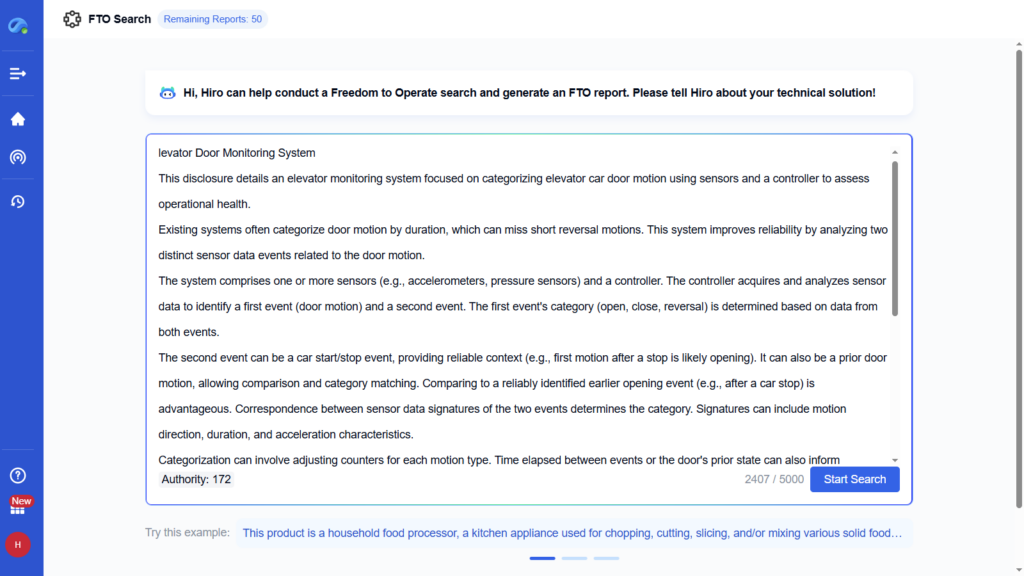
What Is a Traditional Freedom to Operate (FTO) Search?
A Freedom to Operate (FTO) search identifies active patents that might block your product in the market. The main goal is to avoid infringement or find patents that need licensing. Traditionally, patent attorneys or analysts handle this process manually.
Step 1: Identify Key Product Features
The first step breaks your product into core technical features. For example, a startup lists all novel components of their device. These components are then checked against existing patents. Only the features with commercial relevance are considered.
Step 2: Conduct a Comprehensive Patent Search
With features defined, the search begins. Analysts use patent databases to find related patents or applications. They search by keywords, classification codes, and assignee names. Searches are refined through trial and error. Analysts often review citations and patent families to catch hidden risks. This process repeats across every target country.
Step 3: Screen Results and Analyze Patent Claims
After retrieving results, the analyst screens them for relevance. Each patent is carefully reviewed, especially its claims. Independent claims carry the most weight in infringement analysis. Analysts check whether each patent is active, pending, or expired. This helps determine its legal risk.
Step 4: Claim-to-Product Mapping
Analysts create claim charts that map patent claims to product features. If a claim matches all features, the patent may block market entry. If some claim elements are missing in your product, it likely avoids infringement. This mapping step highlights which patents pose high risk.
Step 5: Get a Legal Review and FTO Opinion
All findings go into a formal FTO report. A qualified attorney reviews the charts and legal status of key patents. They give an FTO opinion—confirming whether your product can move forward. If there’s risk, the opinion may suggest redesigns or licensing strategies. This step supports smart business decisions and lowers legal exposure.
Traditional FTO Is Crucial but Demands Time and Skill
FTO searches are vital for companies preparing for launch. But the traditional method requires manual effort, legal knowledge, and weeks of analysis. The process can also be expensive and error-prone. A single missed patent could lead to costly lawsuits.
That’s where AI-based FTO solutions like PatSnap Eureka step in—offering faster, smarter patent risk analysis at scale.
The Role of AI in FTO Searches
Artificial Intelligence is revolutionizing how companies approach Freedom to Operate (FTO) analysis. It makes the process faster, broader, and more reliable. AI tools like PatSnap’s Eureka AI Agent bring automation, accuracy, and scale to what was once a manual task.
In traditional FTO searches, patent analysts spend days crafting keyword queries and reading through lengthy patent claims. That process is slow and prone to missing critical information. AI removes much of this manual effort by reading invention descriptions and understanding their meaning. It uses this understanding to find relevant patents, even if they use different terminology.
AI Understands Your Invention Beyond Keywords
Unlike manual searches that rely on exact matches, AI understands the context behind technical descriptions. It interprets your invention using natural language processing and converts it into a map of related concepts. Then, it searches for patents with similar technical meaning—even if the wording is completely different.
For example, if you describe a “smart elevator system that detects door blockages,” AI can retrieve related patents about obstruction detection, door safety, or elevator automation. This semantic search gives you a broader and more accurate view of potential risks. It also uncovers patents that traditional keyword matching could miss.
Automated Search Strategies Replace Trial-and-Error
AI replaces the step-by-step trial-and-error process with fully automated workflows. A human analyst might run several rounds of keyword refinement and classification lookups. AI runs them all at once. It automates classification-based queries, citation analysis, and keyword exploration—generating smarter results faster.
This efficiency reduces the need to manually tweak queries and chase down patent numbers. AI’s automated approach ensures better coverage across jurisdictions, languages, and technology classes. You don’t just save time—you gain confidence in the thoroughness of your search.
Instant Results Save Time and Enable Fast Iteration
One of AI’s biggest advantages is speed. What used to take a week now takes minutes. When you describe your product or invention, Eureka’s AI instantly matches that input to thousands of active patent claims. You receive a list of potentially relevant patents almost immediately.
This instant feedback means you can quickly assess potential risks and revise product features or development plans. You don’t need to wait days for search reports before moving forward. With fast turnaround, teams can iterate ideas faster and respond to patent risks early.
Improved Accuracy with Conceptual Understanding
Traditional FTO searches depend heavily on keywords and classification codes. If you miss a key term, you may miss a critical patent. AI avoids this by identifying concepts and synonyms. It’s trained on patent data, so it recognizes patterns and understands how technologies relate—even across industries.
This improves the chances of catching high-risk patents early. AI retrieves stronger matches while filtering out irrelevant documents. It gives consistent results, reducing the variability of human-driven searches. With AI, your FTO search is both more accurate and repeatable.
Scalable for Startups and Enterprises Alike
AI systems scale effortlessly. They can review hundreds of thousands of patents from multiple jurisdictions in one pass. Whether you’re a startup or a global enterprise, AI tools adjust to your scope. Startups can use them to perform an initial clearance search before engaging outside counsel.
Larger IP teams can delegate repetitive tasks to AI and focus on strategic review. With Eureka, small teams can achieve what once required entire departments. This democratizes access to patent risk insights and ensures businesses of all sizes can make informed decisions.
AI Multiplies Your FTO Efficiency and Confidence
AI transforms FTO from a reactive legal task into a proactive innovation strategy. It speeds up searches, improves their reach, and increases accuracy. It also supports better collaboration between legal and technical teams.
Instead of spending weeks digging through documents, your team can use Eureka to identify risks, evaluate threats, and adapt faster. With AI, Freedom to Operate becomes more than a checkbox—it becomes a strategic advantage.
In summary, AI serves as a force-multiplier in FTO searches – accelerating the process, broadening the search scope, and maintaining high accuracy. Now, let’s see these benefits in action by walking through a detailed example of an AI-powered FTO search using PatSnap’s Eureka AI Agent.
PatSnap Eureka AI Agent Workflow: Step-by-Step Breakdown
One of the advanced tools bringing AI to FTO analysis is the PatSnap Eureka AI Agent, an AI-powered assistant designed specifically for IP and R&D workflows. The Eureka AI Agent for FTO search (internally nicknamed “Hiro” in the interface) can take a technical description of a product and autonomously perform a multi-round patent search, then help map relevant patent claims – finally producing an FTO report. Below, we break down its workflow step by step, illustrating each stage with screenshots of the Eureka AI Agent in action.
Step 1: Input the Technical Solution Description
The first step is for the user to describe the technical solution or invention in question. Instead of crafting complex Boolean queries, the user simply writes a paragraph (up to several thousand characters) describing what their product is and how it works. For example, the text box is filled with a description of an “Elevator Door Monitoring System” – detailing how it uses sensors and a controller to categorize elevator door motion events. This natural language input provides the AI with a rich context of the product’s features. Once the description is entered, the user clicks “Start Search”. At this point, the AI agent parses the input, understanding the invention’s key concepts and preparing for the search. (Notice the interface indicating “Hiro can help conduct a Freedom to Operate search and generate an FTO report. Please tell Hiro about your technical solution!” – emphasizing the assistant’s role.)
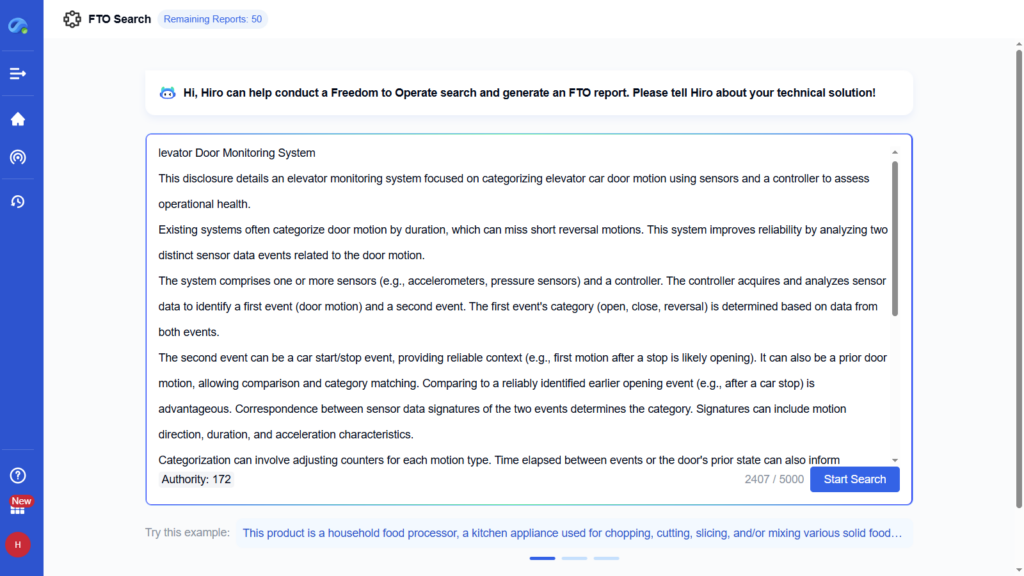
Step 2: AI Extraction of Key Technical Features
The FTO search begins when the user inputs a technical description of their product or invention. Eureka’s AI agent instantly analyzes this text using advanced natural language processing. It breaks down the input into structured technical features, identifying key components, actions, and relationships.
The AI summarizes these features into clear, concise sentences. Each feature reflects a core element of the invention, such as a sensor, controller, or system behavior. These technical features appear as individual, editable checkboxes. Users can review, adjust, or delete any item to ensure full accuracy.
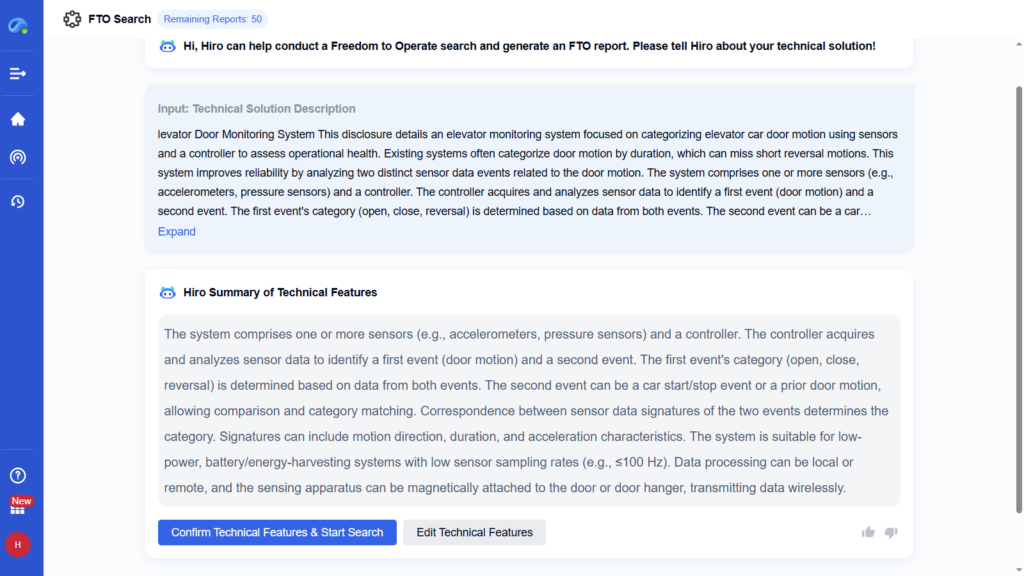
The platform flags items that may need user confirmation or clarification. This collaborative review ensures the search reflects true technical scope. Users can also add missing features manually. Once the feature list is confirmed, they proceed to the next step.
By verifying the technical breakdown first, the AI ensures the following patent search is precise and aligned. It focuses only on the most relevant inventive aspects. This step saves time, reduces risk of misinterpretation, and improves the overall quality of the FTO analysis.
With confirmed features in place, Eureka’s AI automatically runs a global patent search. It retrieves results based on semantic understanding of the technology, not just keyword matches. This ensures deeper, more accurate results—showing potential IP risks you may otherwise overlook.
The process transforms invention descriptions into search-ready data in minutes. AI enables faster, smarter FTO decisions—whether for launching products or avoiding patent disputes. It’s IP clearance built for today’s pace of innovation.
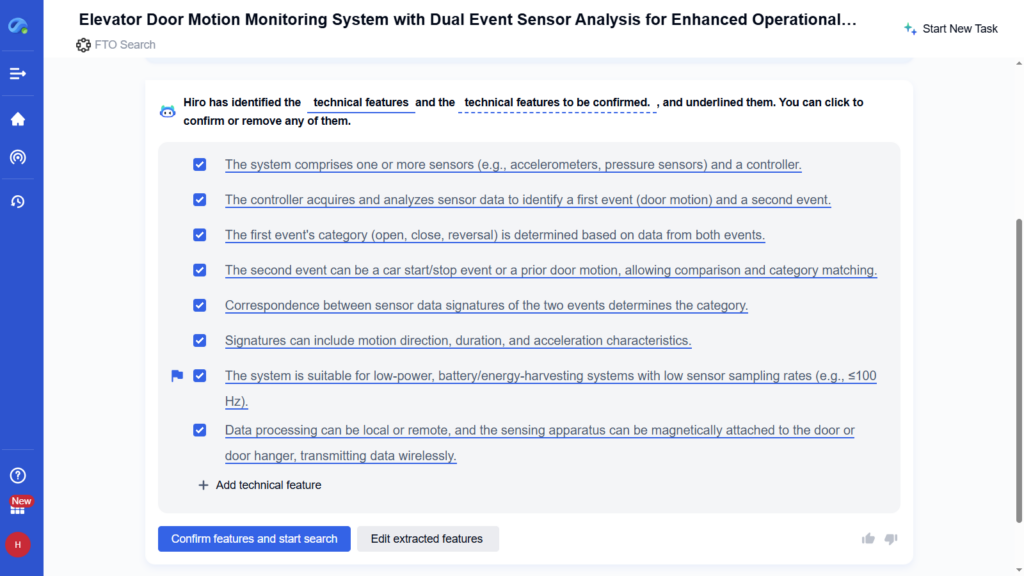
Step 3: Multi-Round AI Patent Search
Once users confirm the technical features of their invention, the Eureka AI Agent launches a fully autonomous multi-phase patent search. It begins with a semantic search, which uses natural language processing to understand the meaning behind the invention and retrieve patents that describe conceptually similar systems—even if different terminology is used. This ensures that early matches are contextually relevant and not just keyword-based.
Following the semantic stage, the agent performs a classification search. It scans across relevant patent classification codes to ensure full coverage of technical domains related to the invention. This step broadens the search beyond keyword matches and captures filings that may use unique jargon but fall under the same innovation category.
Eureka then executes several keyword search iterations, automatically testing different combinations of terms extracted from the invention description. It mimics the process of a skilled analyst who manually adjusts queries, but the AI performs this process rapidly and consistently, reducing the chance of oversight.
To further expand coverage, the agent analyzes each promising patent’s family and citation network. This ensures it includes related patents filed in different countries, as well as earlier or derivative works. By casting this wider net, Eureka catches documents that could pose potential IP risks.
For every matched result, the system maps the claim elements directly to the invention’s technical features. It highlights overlap scores—for example, noting “6 out of 6 features matched”—to quickly identify the most relevant patents. The top matches are automatically added to the report, along with key claim data and impact metrics.
Throughout the process, Eureka logs the number of rounds completed, patents reviewed, and time saved. In real-world use, what could take a human analyst eight hours can be completed in under ten minutes. Users receive clear summaries, visualizations, and a detailed FTO report—making it easier to assess risks and make decisions.
This level of automation transforms freedom-to-operate analysis from a time-consuming legal task into a streamlined, insight-driven process. With the Eureka AI Agent, teams gain speed, clarity, and confidence in navigating complex IP landscapes.

Step 4: Review of Results and AI-Driven Claim Mapping
Once the multi-round search finishes, the Eureka AI Agent presents a list of potential risk patents. These results include detailed claim-to-feature mappings that help assess infringement risk. The AI analyzes each relevant patent and breaks down its independent claims. It compares each element of the claim to the product’s listed technical features.
For each claim element, the agent determines whether the feature appears in the target product. A match is clearly marked as “Yes,” and any mismatch as “No.” This process highlights which patents contain full or partial claim overlaps. If all key elements are present, that patent could pose a risk to freedom to operate. For example, a claim might list “a controller and sensors” while the product includes the same. The agent confirms a full match and signals it as a priority concern.
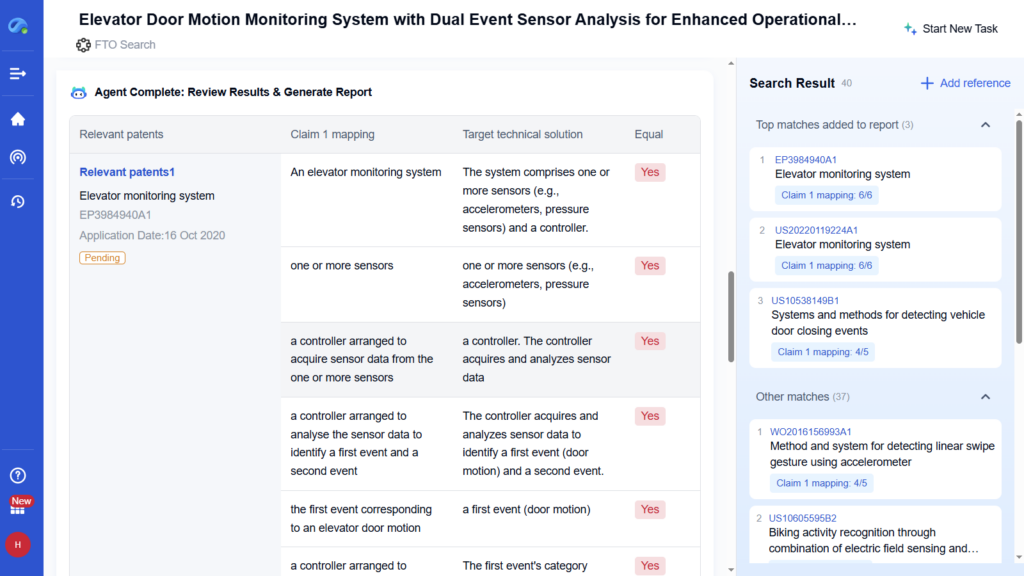
Some patents may contain mixed results. One element might describe a “computer-implemented method,” while the product offers a physical system. In such cases, the AI flags that element as “No.” This tells the user that, while technically similar, the legal claim type might not apply directly. This contextual analysis goes far beyond simple keyword matching. It shows the AI understands the difference between methods, systems, or devices and evaluates their relevance accurately.
After reviewing the mappings, users can refine their final patent list. They might choose to remove weak matches or include other options flagged during the search. This step ensures a curated, focused list of patents most relevant to the FTO risk. The Eureka AI Agent saves professionals hours by preparing these automated claim charts, offering an immediate foundation for legal analysis.
Ultimately, the agent speeds up risk detection and gives teams a detailed, structured path to validate results. Legal teams retain control over final decisions but benefit from a much faster, AI-supported review process.
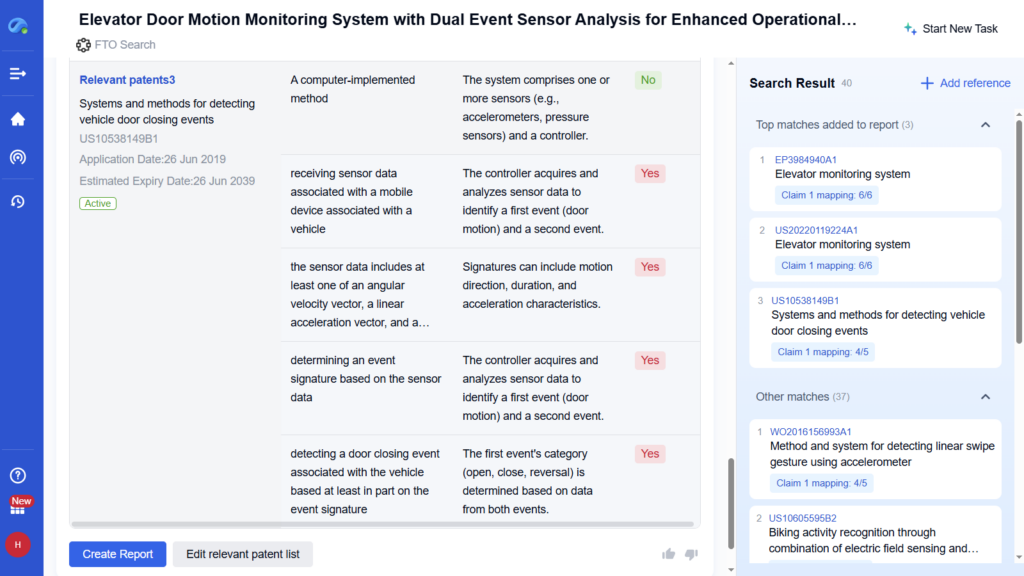
Step 5: FTO Report Generation
The final step in the FTO process is generating a structured, comprehensive report. The Eureka AI Agent compiles this automatically once the analysis ends. It begins with a clear project title and timestamp, offering full traceability for future reference. This ensures everyone knows when and how the analysis occurred.
The report summarizes the AI’s activity, including how many rounds of searching it performed and how many patents it reviewed. For example, it may note, “Completed seven search rounds, compared 45 patents, and identified three top concerns.” This overview gives immediate clarity on the report’s depth.
Next, the report defines the search scope. It lists the jurisdictions and time frame covered, such as “Patents published before April 25, 2025.” This helps readers understand what was included and what might not be visible yet, such as unpublished patent applications.
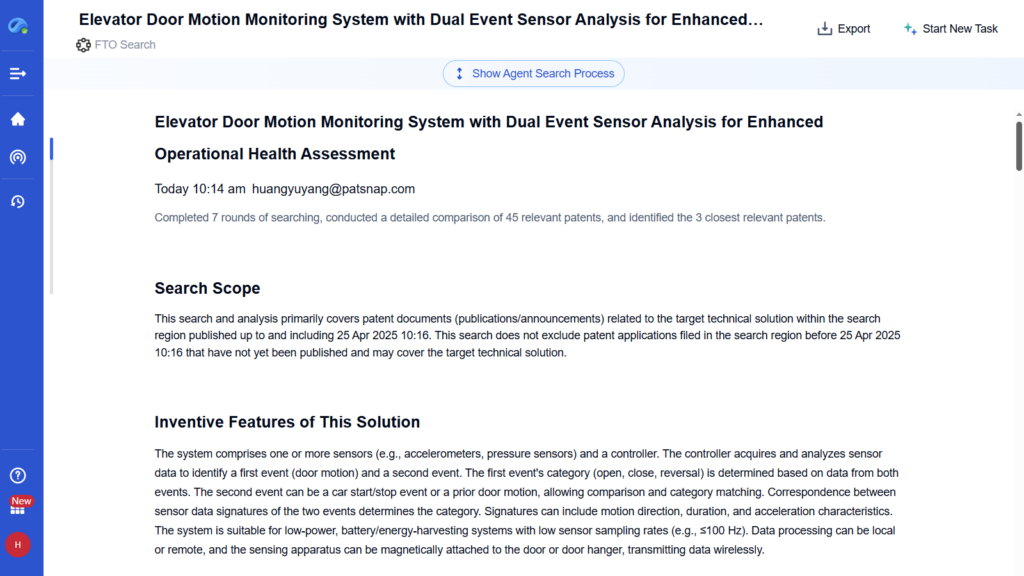
The core inventive features of the product are then listed. These features were extracted earlier by the AI and form the basis of the search. This section ensures the patent screening is aligned with what matters most to the business or product team. Readers can quickly see which technical elements were checked for infringement risks.
The heart of the report includes detailed results. It highlights the most relevant patents and explains how they compare to the product features. It includes legal status, potential risks, and whether additional review is advised. The agent provides clear, mapped comparisons between claims and product features, along with suggested next steps.
This AI-generated FTO report saves legal teams significant time. It eliminates hours of search work and condenses insights into a single, readable format. For innovators or startup founders, it offers a straightforward view of patent risks without needing expert-level IP knowledge.
Traditional vs. AI-Enhanced FTO Search: Comparison
How does a traditional FTO search stack up against an AI-enhanced FTO search (like using Eureka AI Agent)? Below is a comparison of key factors:
| Aspect | Traditional FTO Search | AI-Enhanced FTO Search (e.g., PatSnap Eureka) |
|---|---|---|
| Efficiency | Time-consuming manual process; weeks of searching and analysis for a thorough result. | Highly automated and fast; can complete multi-round searches in minutes, dramatically reducing turnaround time. |
| Accuracy | Quality depends on the searcher’s experience; risk of missing patents if keywords or classifications are not chosen well. | Semantic AI search finds relevant patents by concept, catching variants a human might miss. Reduces human error and uses exhaustive algorithms for thoroughness. |
| Repeatability | Results can vary between different analysts; manual searches are hard to exactly replicate, and human bias may affect findings. | Consistent results for the same input every time. AI follows the same methodology, ensuring repeatable and objective searches. |
| Scalability | Difficult to scale – each new search or expanded scope requires proportional human effort; handling very large sets of patents is impractical. | Easily scalable – the AI can search across huge databases and multiple jurisdictions without extra effort, and can run multiple projects in parallel. |
| Usability | Requires specialized expertise in patent search tools and legal claim interpretation; typically done by patent attorneys or search firms. | User-friendly – accepts natural language input. Non-experts (like startup founders) can get initial insights. IP professionals can use it as a decision-support tool, focusing their expertise on reviewing AI-curated results. |
As shown above, AI-enhanced FTO search offers clear advantages in speed and breadth. It is not necessarily about replacing human experts, but augmenting their capabilities. The AI can sift the haystack to find the needles, and the expert can then apply legal judgment to those needles.
Conclusion & Key Takeaways
For modern IP teams and innovators, tools like Eureka AI Agent represent a significant evolution in how Freedom to Operate searches are conducted. By combining AI’s speed and semantic intelligence with the oversight of human expertise, organizations can achieve faster and more reliable patent risk assessments. In our walkthrough, we saw how Eureka AI Agent can take an inventor’s description, automatically generate search queries, scour patent databases, and even draft claim maps and reports – all within a single guided workflow. This level of automation means patent risk analysis that once took days can now be done in a morning, allowing businesses to make informed decisions more quickly.
So, when should one use an AI FTO search versus a traditional approach? A few guidelines emerge:
- Early-Stage Exploration: During product development or preliminary due diligence, an AI-driven FTO search is ideal. It provides quick feedback on whether any obvious blocking patents exist, enabling R&D teams or startup founders to course-correct early. Because it’s fast and low-cost compared to a full legal analysis, it can be repeated whenever the product design changes or new features are added, ensuring ongoing awareness of the IP landscape.
- Comprehensive Clearance & Legal Opinion: Before a major product launch or investment, companies might still opt for a traditional FTO analysis by patent attorneys, which could include manual double-checking and a formal legal opinion letter. In such cases, AI tools can still play a supporting role – the attorney can use the AI results as a starting point, significantly reducing the time spent. The combination of AI findings with expert validation offers the best of both worlds: efficiency and rigor.
- Resource Allocation: For startups with limited budgets, AI-based FTO search provides an opportunity to conduct a patent risk assessment in-house to a reasonable extent. It helps identify if there are any “red flag” patents that warrant hiring a lawyer. This way, founders can go into conversations with legal counsel already armed with some knowledge of the landscape (perhaps even the Eureka-generated report), potentially saving billable hours.
In conclusion, the PatSnap Eureka AI Agent and similar AI tools are powerful new alternatives for FTO searches that can greatly enhance the workflow of IP professionals and entrepreneurs alike. They deliver efficiency, consistency, and depth of analysis that were hard to achieve with purely manual searches. Embracing an AI-enhanced FTO search doesn’t eliminate the need for human expertise – rather, it frees those experts to focus on strategic decision-making and nuanced legal analysis. As the patent world continues to grow in complexity and volume, leveraging AI for freedom-to-operate inquiries will become increasingly standard for those who want to stay ahead of the curve. Whether you’re a patent attorney ensuring your client is clear to launch or a startup founder doing your homework before going to market, AI-driven FTO search is a game-changer that can provide peace of mind faster and more efficiently than ever before.
Ultimately, ensuring freedom to operate is about mitigating risk – and with AI on your side, that process becomes far more streamlined and insight-rich. Eureka AI Agent exemplifies how technology can uphold the thoroughness of traditional FTO analysis while eliminating much of the toil, making modern patent risk management both smarter and more accessible.
To get detailed scientific explanations of FTO search, try Patsnap Eureka.

